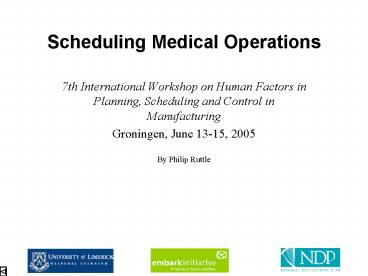Scheduling Medical Operations - PowerPoint PPT Presentation
1 / 26
Title:
Scheduling Medical Operations
Description:
Reported number of patients waiting for elective treatment, quarterly, March ... Anaesthesia. Operation. Recovery. Variability ... – PowerPoint PPT presentation
Number of Views:57
Avg rating:3.0/5.0
Title: Scheduling Medical Operations
1
Scheduling Medical Operations
- 7th International Workshop on Human Factors in
Planning, Scheduling and Control in Manufacturing
- Groningen, June 13-15, 2005
- By Philip Ruttle
2
Backround - Motivation
3
Reported number of patients waiting for elective
treatment, quarterly, March 1993 to December 2002
4
Expenditure under the Waiting List Initiative,
1993 to 2002(strategic workaround send patients
elsewhere)
5
Waiting Times for Elective Surgeries
Current Situation wait for more than 3 in 4
patients is gt 4 months
The Aspired Target none gt 4 months!
6
Problems on the Ground Experienced by Surgeons
- Example
- Salient context
- Coronary by-pass operations
- Situation
- Surgical team gowned up
- Theatre ready
- Problem No patient
- Consequence Operation cancelled
- Why?
- No porter available
- Occurrence one of many issues of annoyance
- something must be done can someone look into
this - potential opportunity
7
Operations Scheduler Activity Goals?
How do you improve one without NEGATIVELY
affecting the others? Assumption Currently focus
is on trade-offs Aspiration improve on all
fronts. (Improve on Pareto Optimality)
Constraints
8
Work Plan Personal Criteria
- To be novel
- To be useful
- To be field-based
- To add to knowledge at conceptual/abstract level
- To be valid
9
Work Plan Line of Attack
2 Pronged Approach
Long term Interfacing/supporting
process Abstraction Frameworks General Application
to support system design Future processes/future
system?
- Short term
- Attention to the tangible
- Process intervention at physical level
- Build interest
- Low Hanging Fruit
- Limited conceptual depth?
10
Plan (Short-Term)
- Speculative
11
Plan (Short-Term)
- Observe suggest process control (queue
discipline?) intervention - Who, What, When, Where, How, Why.
- Current process structure
- Constraints
- First conventional
- deepen
- Process Times (measurable ?)
- Setups/ changeovers (measurable ?)
- Associated Variability
- TOC packaging after
- identify spare capacity/queue control
intervention? (emergent from TOC observations) - Why? - Tangible gains build interest/cooperation
- Karvonen, S., et al., Productivity improvement
in heart surgery - a case study on care process
development. Production Planning Control, 2004,
Vol. 15, 238
12
Who, What, When, Where, How.
- Gain Basic Knowledge of the Process
- Is an Entry Level Analysis
- Technical ordering
- Production Flow Analysis
- Locus of decision/activation
- Who currently does it (actors)
- Where
- Timing
- When/how often
- Conditions under which taken
- Situations/pressures
- Limitations/ constraints
- Data (and quality)
- Objectives of activities
- Process physics
13
Data Collection
- existing records where available
- activity sampling
- structured interviews
- critical incident technique
14
Process Times
- Whats the underlying distribution?
- Gamma
- Seung-Chul, K., et al., Flexible bed allocation
and performance in the intensive care unit.
Journal of Operations Management, 2000, Vol.
18(4), 427. - Lognormal
- Spangler, W., et al., Estimating Procedure Times
for Surgeries by Determining Location Parameters
for the Lognormal Model. Health Care Management
Science, 2004, Vol. 7(2), 97. - Conclusion Are definitely Skewed
- Few very short
- Many in central region
- Few very long
- Many questions not answered
- Eg how much variation lies on a predicted value
- Possibilities for reducing error ranges
15
Process Times
- How do you Predict it
- Factors to Consider
- The procedure
- The Surgeon
- Training
- What are its Constituent Parts
- Set-up
- Preparation
- Anaesthesia
- Operation
- Recovery
16
Variability
- Variability underlies WIP Hopp and Spearman,
Factory Physics - i.e. patient queues
- Demand Uncertainties
- Process Times
- Predicted vs. Actual
- Analogy reverse manufacturing /disassembly
- Changeover Time
- Shingo, Non-stock Production
- Monden, The Toyota Production System
- Variability as a Source of Waste (7 forms of
waste etc ) - Smooth Flow
- as a Virtuous Circle
- How Achievable? more in the aspiration than in
reality? - Neglected?
- Variety Urgency
17
Flow (TOC)
- Patient flow
- What are the Resources
- What are the activity Sequences
- What are their volumes and capacities
- Which are Constraining
- Are they Static/Dynamic
- Discrete/continuous
18
Setups
- Magnitude
- Potential for capacity-making
- Structure
- Set-up
- Preparation
- Are Setups Sequence Dependant?
- What Causes the Dependancy
- Can Setup Time be Reduced?
- What Parts are External and Internal
19
Longer Term
- highly speculative
20
Karvonen et al (2004)
- Very specific opportunity for research
collaboration - Mix of socio and technical
- Cross-dept
- TOC (search)
- Process flow (PFA / Burbidge)
- Bottleneck
- Process Opportunity to make use of spare
safety-stock capacity - Solution
- Subordinate to this to the givens
- Two-queue
- Improve system
- Organisation change
- Tangible Result
- Dramatic improvement in queue length
- improvement in patient health outcomes not
measurable - This was their outcome path specific to them
21
- Missing-
- Human decision-making process
22
Longer Term
- Work Needs interpretational frameworks -
conceptual
23
Work Domain Analysis (Goals and Players)
(Higgins/Vicente-Rasmussen)
Whole Parts
Purpose Physical
Abstraction Hierarchy
24
McKay 7-step process
25
Plan (Long-Term)Follow this route (Higgins)
Decision Ladder Activate Observe Identify Interpre
t Evaluate Task Process Implement
26
- Open for ideas































